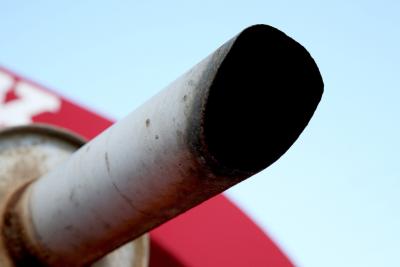
There may be a few different reasons why a muffler on the exhaust system of your vehicle goes bad. Although many new systems are constructed of stainless steel, mufflers can deteriorate from the inside out due to condensation built up inside of them. External muffler deterioration can occur on cars driven on roads where salt is used in excess during winter. No matter what the geographical region, the muffler and other exhaust components are going to require replacement after extended use.
Every model of every make of car and truck has its own unique exhaust system. This presents certain challenges when trying to replace a muffler. The position of the muffler on most cars is near the back bumper, on the left or right side. However, on a light truck or SUV, the muffler may be found directly behind the catalytic converter, about halfway down the exhaust system. This type of system employs a longer tailpipe that hops over the rear axle.
Before removing the muffler, it's important to inspect and study the system to determine what you have to work with, and how you're going to put it back together, as close as possible to its original positioning. Exhaust systems are carefully measured and employ flex pipe sections (an accordion-shaped pipe section covered in mesh), or rubber hangers with pipe and muffler hooks (or all of the above). The positioning of the hooks and hangers is important to ensure the system is restored properly after installation of any new exhaust component. The flex sections and rubber hangers are integrated on exhaust systems to allow movement of the system when the motor starts and under heavy torque demand. Engines move around in their cradle quite a bit, and if the exhaust system didn't allow for the movement of the engine, they would snap off.
When installing a new muffler, you'll need to make proper measurements to ensure the new muffler is positioned exactly, or as close to exact as possible to the original. This will ensure that the rest of the system is not tweaked slightly due to the new muffler installation. There is very little margin for error allowed on exhaust systems these days.
Is the muffler attached to the pipes in front and/or behind it by flange connections, clamps or is it welded? Knowing the answer to this question will determine what tools you will need to successfully install the new muffler.
Flange connections may seem easier to work with, but the bolt or stud connections will undoubtedly be rusty and difficult to separate. Oxyacetylene torches will easily cut through the old bolts or studs, but are dangerous to use unless the car is up on a commercial lift.
Clamp connections present a challenge once the clamp is removed because the clamp has crimped the connection in a circular fashion. This crimp needs to be worked out enough to allow separation of the pipe and muffler. Again, use a torch to heat up the crimp (cherry red) and then move the muffler back and forth and lift it up and down to decrease the crimp.
Welded systems also present their own challenge. Very rarely will you find a system welded to the muffler that allows you to cut the pipe in front of the muffler with an exhaust cut-off tool, and then rehang the muffler without compromising its positioning. In many of these cases, special pipes need to be made in order to attach to the inlet of the muffler and to the exhaust pipe. Another easier, but less cost effective suggestion, is to replace the system, from the catalytic converter back, in sections. Most all aftermarket exhaust systems feature the systems in separate components, to make it easier to reinstall.
For the do-it-yourself exhaust enthusiast, working on an exhaust system while laying on your back is not a fun job. Trying to tackle the challenges presented in Section 2 is going to be frustrating and you'er going to lose strength and leverage. Exhaust systems can be hard enough to work on when they're on a commercial lift, but you'll have more strength and leverage and more mobility to move when working with torches.
There are some exceptions to the rule. There are some makes and models where the muffler can simply be cut off and a new one retrofitted back on by employing sleeve connections and clamps. This is hardly ever the rule. And the newer the vehicles, the more complicated and technical the exhaust systems are going to be.
There are many safety issues to consider when removing and installing a muffler on a vehicle. Safety glasses or goggles should be worn to prevent rust from getting into your eyes. Safety gloves made of thick leather should be worn to prevent injury to your hands, or when using a torch. The vehicle should be lifted and supported properly on a commercial lift or on jack stands and car ramps. While removing and installing a muffler, you'll be shaking the exhaust system around, and a vehicle not properly supported can fall and cause serious or fatal injuries.